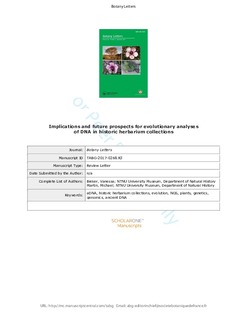| dc.description.abstract | Global herbarium collections house a vast number of plant specimens stretching back over centuries. They include rare and extinct species, important historical collections, and valuable type specimens that could help to resolve long-standing taxonomic issues. Historical plant collections also provide unique windows into past evolutionary processes and population histories that do not exist with modern data alone. However, because the DNA in such specimens is often degraded and scarce, manipulation and analysis of their genetic material can be challenging. Recent developments in non-destructive genetic sampling and working with very small quantities of genomic DNA, especially in next-generation sequencing and bioinformatic analysis of ancient DNA, now make the majority of herbarium specimens potentially accessible to phylogenetic, population genetic, and barcoding studies. For example, studies of DNA from long time series of Ipomoea batatas and Anacamptis palustris collections revealed linkages between anthropogenic activity and changes in haplotype distribution. These time series also enable the identification of genes under recent selection in the genomes of both the plants and their pathogens, as was shown for Phytophthora infestans, a microbial pathogen of Solanum tuberosum. Here, we summarize the major challenges in using historical plant DNA in evolutionary studies and review genetic studies integrating herbarium specimens. We expect future genetic studies of historical herbarium specimens to use genomic, metagenomic, and population genetic approaches to: investigate how plant populations respond to environmental change; infer temporal changes in genetic diversity; identify genes under recent selection; and investigate past plant pathogen epidemics. | nb_NO |
